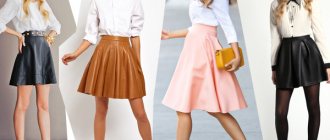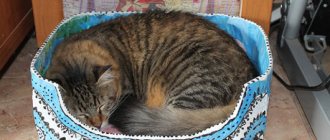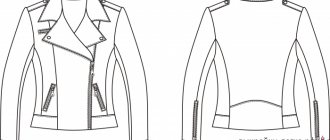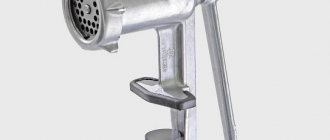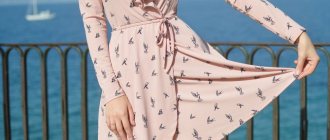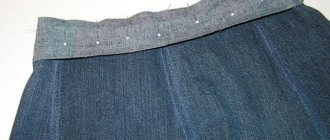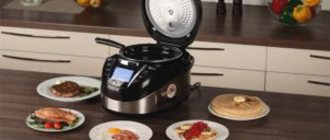How to calculate the amount of fabric for a suit?
If this is a men's or women's suit, then the length of the sleeve is added to the length of the jacket with allowances for hemming the bottom of the garment and the sleeves. The fabric consumption for the shirt is also calculated. To calculate the fabric consumption for trousers, measure the length of the trousers to the waist, and add 15 - 25 cm to this measurement.
Interesting materials:
What are the dangers of crib bumpers? Why are acids dangerous? Why are Reduxin tablets dangerous? How to spray phlox in the fall? How to open compass files? How to open a WebM file? How to clean the floor from dirt? How to clean the floor from stains? What does the Basilisk eat? What does a hare eat in the steppe?
Features of a half-sun skirt
The peculiarities of this model lie primarily in the style itself: the skirt fits the figure with soft folds, which ensures that it is cut differently from straight skirts - along an oblique line.
pros
This model is one of the most popular, and there are well-founded reasons for this.
These include:
- ease of pattern construction;
- ease of sewing;
- no additional calculations for darts;
- Can be used for sewing any fabric;
- versatility of the model;
- comfort (does not restrict movement)
- suitable for any age (both girls and women);
- goes with most things.
In addition, such a skirt perfectly emphasizes the advantages of the figure, while hiding flaws.
How is it different from a circle skirt?
The half-sun skirt (the DIY pattern will be offered step by step below) has several differences from a similar product, the main one of which is the width of the hem, which is ½ circle.
A circle skirt is a more flared, fuller model, so it is usually sewn longer and is rarely cut from one piece of fabric. In addition, it is not suitable for any figure, since a large number of folds and waves formed in the waist area increase the hip line. The half-sun is a more versatile model.
Instead of an afterword
Regardless of what style of clothing a girl prefers, a half-sun skirt will always have a place in her wardrobe. After all, such a model fits perfectly into the image of a romantic, gentle nature and femme fatale vamp. This can be a warm winter option, or vice versa, a detail of a beach ensemble. You just need to choose the appropriate style that matches your type of activity and age category. Cutting and sewing such a skirt with your own hands will not be difficult even for novice seamstresses who are just beginning to master the basics of this exciting activity. After all, the number of necessary parts for the product is minimal, and the sewing technology is quite simple for beginners.
Materials
To sew a half-sun skirt for a girl, a girl or a woman, you need a fabric that has high plasticity and holds its shape. For summer options, lighter and thinner materials are suitable. The most commonly used for sewing these products are:
- Tweed. This is a wool material with a textured surface. It is practical, warm, and allows you to achieve clear folds on your skirt. Thanks to its texture, the material gives additional volume, which is especially important for women with very narrow hips. For plump ladies, it is better to avoid such fabric.
- Fatin. Light, smooth material, from which holiday products are often sewn. The volume of the skirt depends on its rigidity. You can combine it with different blouses and tops. Disadvantages of tulle: it is highly electrified and can become deformed when placed near heating devices.
- Denim. This option is used for everyday wear. The fabric is thin and natural, so it will not cause discomfort even in the summer heat. As for the folds, they are made in the form of natural gathers. Denim fades over time and may sag after washing.
- Leather. The material is suitable for those fashionistas who are not afraid to experiment. It is better to use medium or long models. Thanks to the natural shine of the skin, the folds create beautiful shimmers, so the look will be bright, even if the top is dark in color. The disadvantage of the material is its high cost.
- Knitwear. To sew such a skirt, you need fabric with a dense texture. This material often does not have artificial folds. The relative disadvantage is that it looks simple.
- Chiffon. Used for sewing floor-length summer items. This material allows air to pass through well and hides some silhouette imperfections. It is somewhat capricious in care, so you need to handle it with care.
- Chintz. Natural lightweight fabric used for sewing summer skirts. It is pleasant to the touch and can be plain or with a printed pattern. This material allows air to pass through well, but quickly wrinkles, shrinks when washed, and is damaged when exposed to high temperatures.
- Suede leather. This skirt is soft, velvety, silky. Its texture is porous. It is better to use an artificial version, as it practically does not wrinkle and holds its shape well. For tailoring, you can choose any shade.
It is better not to use natural linen for sewing, as it quickly wrinkles and shrinks when washed. Cotton also has the same disadvantages, which, moreover, wears out quickly.
Tweed
Fatin
Denim
Leather
Knitwear
Chiffon
Chintz
Suede
Building a basic pattern
The construction of a half-sun skirt pattern begins with creating a right angle on paper.
Next you need to note step by step:
- Waist line (P1);
- Hem line (P2).
How to draw a bottom line
An easy way to create a hem line: take a ribbon or rope and attach a pencil to the end to the length of P2. Secure the beginning of the tape at the head of the corner, and draw a hem line at a distance P2.
An easy way to draw a circle
Uncover
I lay the fabric on the table, straighten it, take a measuring tape and start drawing the waist section.
From the corner at the top I mark 30 cm.
Then, using the principle of a compass, I leave the top of the tape in the corner, move the tape itself and put marks.
I raise the waist line diagonally by 1 cm, mark 29 cm. And then again 30.
I connect the marks with one arc.
Then I make the second arc in the same way. In my case, 91 cm. Diagonally I mark 90 cm, 1 higher, the same as at the waist.
I cut along an arc of 91 cm. Then I put the cut side on the opposite corner, align it very carefully, and fix it with needles.
I cut off the second part of the skirt along the first at the bottom and cut off both at the top.
The belt is made up of two parts, each 47 cm long. The elastic band is 3 cm wide, so the width of the belt strips is 8.5 cm.
I cut out the pockets into whatever shape I like. Straight side - pocket entrance - 17 cm.
Greetings, friends!
It's already the middle of summer. My summer days are not wasted. Today I have prepared another master class for you: How to sew a “Half-sun” skirt .
Do you want to sew a half-sun skirt, but don’t know how to do it yet? Stay here and you will learn how to construct a drawing of a Half-Sun skirt , how to get a pattern for a Half-Sun skirt with one seam or with two side seams, how to cut and how to sew a Half-Sun skirt . In fact, there is nothing complicated in sewing it, and the resulting result will certainly delight you all summer.
What we need:
- Fabric - 1 m (the amount of fabric will depend on the length of the skirt);
- Concealed zipper - 1 piece;
- Sewing machine;
- Sewing supplies;
Construction of a drawing of the “Half Sun” skirt.
Before we start building a drawing of the Half-Sun skirt , I would like to say a few words about the Half-Sun skirt. This skirt style is a great choice if you like flared skirts but don't want to add visual volume to your hips.
Let's get started.
In order to create a drawing for the “Half Sun” skirt pattern , we will need the following measurements. Below, as an example, I took my measurements.
St (half waist) = 36 cm
Fri (half hips) = 48 cm
Du (skirt length) = 66 cm
Fri (waist increase) = 1 cm
We construct a right angle with the vertex at T.O. We mark our measurements on the vertical line: the waist line, the hip line and the bottom line of the skirt.
To find out the distance from the b.o. to the waist line, we use the formula:
OT = K*(St + Fri),
where K is the coefficient of curvature of the upper section of the skirt. For a half-sun skirt it is 0.64 cm.
OT = 0.64*(36+1) = 23.68 cm
Next, from point T downwards we lay down a segment TB = 18-20 cm. This segment is standard. You can take a measurement from the side waistline to the most prominent point of the hip for greater accuracy.
I set aside 20 cm. Now from point T we set aside the length of the skirt (in our case 66 cm) and put point H. We transfer all the points to the horizontal segment of the drawing and connect all the points, designating them as T1, B1, H1, respectively.
By the way, when you finish constructing the drawing, measure the volume of the skirt along the hips so that it is not less than the taken measurement of the hip volume.
Voila, we have a ready-made drawing for the “Half Sun” skirt pattern.
How much fabric do you need for a half-sun skirt?
The amount of fabric for a half sun skirt will depend on how you lay it out on the fabric. By the way, what it will be like, single-seam or double-seam, will also depend on this.
For a skirt length of up to 70 cm, we will need 2 meters of fabric with a minimum width of 110 cm, i.e. in this case, the hip volume should not exceed 100 cm.
With this layout of the pattern on the fabric, we will get a “Half-sun” skirt with one seam (see figure below).
Another method involves less fabric consumption, but the skirt will have two side seams. According to some information from the Internet, this method of laying out a pattern on fabric has another advantage. The braid will be located in the center of the front and back, which means the coattails will lie very beautifully. Whether this is actually true, I cannot say. Because, as an example, I sewed such a skirt in a reduced scale of 1:4. And I cut it out the first way.
I would also like to add that I really liked this skirt model, even in the smaller version, so soon I will definitely post photos of the sewn “Half-Sun” skirt in a normal size forty-two :).
I will also add that the fabric consumption may be higher, it all depends on what kind of fabric you have. If the fabric has a pattern, for example, a check, then in this case you will have to take into account the direction of the check along the seam lines so that the check matches.
Half-sun skirt with one seam.
We trace the resulting pattern on the fabric using any of the above methods. Don’t forget to leave a seam allowance of 1.5-2 cm on the side sections and hems at the bottom, and 1 cm for attaching the waistband. Cut it out.
After cutting 1-2 cm from the top cut along it, make 2 parallel lines - this will prevent the cut edges of the skirt from stretching while working with it.
Important (!) Baste the edges of the side sections of the skirt and hang them for a couple of days. To do this, you need to position the waist line horizontally and secure it with pins. What will it give? The skirt will stretch during this time, especially along the bias thread. After this you can start sewing.
We make calculations for the skirt waistband. I have already written how to do this earlier, so I will skip the description of this stage at this point. How to calculate the size of a belt for a skirt and how to sew a belt to a skirt, see here .
Having cut out and processed the belt for the skirt, we baste it to the upper section of the skirt. Let's sew. Fold it in half and stitch again. Don’t forget to iron the pieces while sewing, this will make sewing easier.
Don't pay attention to the seam in the middle, it shouldn't be there, I mistakenly cut out two separate pieces instead of one whole piece. Next, we process the bottom of the product. We make a hem, baste and stitch.
We sew in a zipper. Again, you can watch a detailed video on how to sew a hidden zipper in one of the previous posts. I didn’t sew a zipper into this skirt because I didn’t have such a mini zipper :).
Agree, everything is very simple. Your new thing is ready! This is the miniskirt I ended up with.
If you doubt that you will be able to sew this skirt the first time, try sewing this sample. There is absolutely nothing complicated, and I am sure that you will succeed the first time. I really liked the “Half Sun” skirt; in the near future I will definitely make such a skirt for myself. Good luck!
PS If you have anything to add on this topic, leave comments using the form below, I’ll be happy to read them :).
PPS Subscribe to blog updates, join our groups on social networks VK (add your work here) and Facebook so you don’t miss anything.
PPPS Friends, if you subscribe to the newsletter and have not received an activation letter, do not forget to check your Spam folder, it is quite possible that the activation letter ended up there.
Author: Anna.
Who is it suitable for?
We can safely say that this model is suitable for all types of female figures. She corrects shortcomings and emphasizes the advantages of the owner. So, for girls with a weakly defined waist it emphasizes it, for girls with a pear-shaped figure it balances the top and bottom, and for a T-figure, on the contrary, it adds volume in the missing places.
A well-chosen style visually added height and reduced the volume of the figure.
Length options
Regardless of the length of the product, such a skirt is suitable for girls and women of different heights. When choosing, be sure to take into account the features of the figure. There are the following varieties depending on the length:
- Mini. It looks good on tall girls with slender legs. This model is also suitable for short fashionistas, but it must be combined with heels to lengthen the silhouette.
- Midi. This is a universal option suitable for everyone. Here the product reaches the knee. You need to choose shoes with high heels or wedges.
- Long model. To choose a half-sun skirt, you need to take into account your body type. If a girl is curvy, then it is better for her to give preference to a product with an elastic band made of dense material. Pleated options are suitable for slender women.
For very young and thin girls, there are very short models. The choice of length depends on the purpose of using such clothing. Each of them can be used for everyday wear. Long models are considered more festive.
Short
Midi
Long
Types of skirts
Skirts are divided by cut, silhouette and length.
Skirts are classified according to length:
- mini - 15 cm above the knee;
- to mid-thigh;
- to the knee;
- midi - to the middle of the shin;
- maxi - to the ankle.
The silhouette of the skirt can be:
- straight;
- tapered to the bottom;
- widened towards the bottom;
There are many options for cut skirts. Among them are:
- pleated skirts;
- sun and half-sun skirts;
- wrap skirts;
- pencil skirts;
- pleated skirts, etc.
Modern fashion gives preference to skirts in pastel colors. Pleated skirts are especially popular.
For women with an hourglass figure
For ladies with developed hips, a semi-sun skirt will be the ideal choice. Important details:
- It is advisable to choose a fabric for a skirt that drapes well, creating soft ruffles;
- the model should be high-waisted and have a perfectly fitting belt;
- the flare should start from the middle of the thigh;
- The length of the skirt is to the knees and below.
Cutting and sewing tools
A standard set of tools for sewing a product looks like this:
- Tailor's rulers;
- Tape measure;
- A set of sharp scissors of different sizes;
- Graph paper;
- Chalk for pattern;
- Pencil, eraser;
- Sewing machine;
- Iron/steamer.
Set of tailor's rulers
Required measurements
Attention! Any tailor's work begins with taking measurements.
For this you need a tape centimeter. Measure your waist circumference, hip circumference and desired length. It is advisable to write down the measurements taken. Since you can’t get confused in them even by 1 cm.
Ironing process
These types of skirts need to be washed very carefully. Due to the large number of folds, they should not be pressed at high speeds. You can dry it in any position; ironing is allowed only at a temperature of 40-45 degrees.
In conclusion, it should be noted that making a half-sun skirt is quite simple. It is important to know all the measurements and the formula by which you need to calculate fabric consumption. To understand how much fabric is needed for a semi-sun, you need to look at sample product models on the Internet and choose something for yourself. The only difficulties that may arise are calculating the radius for the skirt. For beginning tailors, it will be difficult to figure out the formula at first. But to do this, you can go to various forums, where they can describe what it is and how to calculate it.
